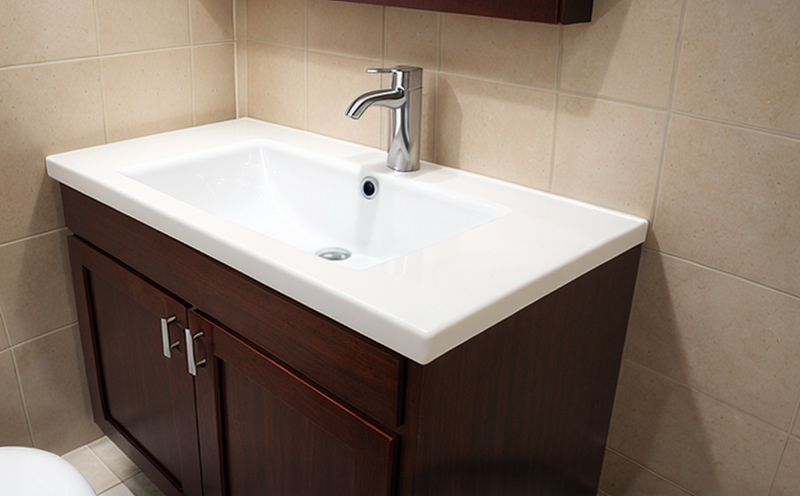DIN EN ISO 604 Compression Testing of Sanitary Plastics
The DIN EN ISO 604 compression testing method is a critical procedure employed in quality assurance and compliance verification for sanitary plastics. This test assesses the compressive strength of materials used in bathroom fixtures, such as sinks, toilets, and baths, to ensure they meet stringent performance standards. The process involves applying uniform pressure across a sample's surface until it yields or fails at a specified load. Compliance with this standard is essential for manufacturers aiming to produce durable, reliable products that comply with international quality benchmarks.
The test procedure requires precise specimen preparation using standardized dimensions and tolerances as per the DIN EN ISO 604 specification. Samples are typically cut from larger production batches to ensure representativeness of material properties under real-world conditions. The compression testing machine used must be calibrated according to relevant metrological standards, ensuring accurate measurement of applied forces.
The significance of this test lies in its ability to predict the long-term performance and durability of sanitary plastics across various environments. By subjecting samples to controlled compression loads, manufacturers can identify potential weaknesses or areas for improvement before product launch. This approach helps minimize post-market failures due to unexpected material behavior under load.
Compliance with DIN EN ISO 604 is particularly important in the bathroom and sanitary sectors where high-quality materials are paramount. Non-compliant products could lead to safety hazards, reduced lifespan, or consumer dissatisfaction—all of which impact brand reputation and market share. Therefore, implementing rigorous quality control measures through tests like this one ensures consistent product performance across all units manufactured.
For R&D engineers working in the bathroom fixtures industry, mastering DIN EN ISO 604 compression testing offers valuable insights into material behavior under stress conditions. This knowledge can inform design iterations aimed at enhancing product robustness and user satisfaction while adhering to regulatory requirements.
| Test Parameters | Specification |
|---|---|
| Sample Dimensions | As per DIN EN ISO 604 |
| Applied Load Range | Defined by standard |
| Environmental Conditions | Standardized temperature and humidity |
| Instrumentation | Description |
|---|---|
| Compression Testing Machine | Calibrated to ISO standards, capable of precise force measurement. |
| Samples Cutter | Ensures uniform specimen preparation according to DIN EN ISO 604 specifications. |
The test results provide critical data on the compressive strength and deformation characteristics of sanitary plastics. These metrics are used by manufacturers to refine production processes, select optimal materials, and optimize product designs for better performance and longer service life.
Why It Matters
DIN EN ISO 604 compression testing is crucial because it directly impacts the reliability and safety of bathroom fixtures. By ensuring that sanitary plastics meet rigorous strength requirements, this test helps prevent accidents caused by structural failures. For instance, a weak sink or toilet could pose risks to users, especially those with mobility challenges.
From a business perspective, compliance with DIN EN ISO 604 standards can significantly enhance brand reputation and customer trust. Consumers are increasingly aware of the importance of product quality, and failure to meet these benchmarks may result in negative publicity and lost sales opportunities.
- Enhanced Consumer Confidence: Meeting international standards builds consumer confidence in a brand's commitment to safety and quality.
- Avoidance of Legal Issues: Ensuring compliance with DIN EN ISO 604 prevents potential legal disputes related to product defects or injuries caused by non-compliant materials.
- Premium Pricing Potential: Products that consistently meet high-quality standards may command premium prices in competitive markets.
In summary, adherence to DIN EN ISO 604 compression testing is not just a regulatory requirement but also a strategic move that supports brand integrity and market success.
Industry Applications
| Application Area | Description |
|---|---|
| Sink Manufacturing | Tests the compressive strength of materials used in sink construction to ensure durability and safety. |
| Toilet Production | Evaluates the structural integrity of toilet components under compression loads, enhancing user comfort and hygiene. |
| Bath Fixture Design | Assesses the load-bearing capacity of bath fixtures, contributing to improved ergonomics and longevity. |
The test is particularly vital in the manufacturing process for bathroom and sanitary products. It helps manufacturers identify potential weaknesses early on, allowing them to make necessary adjustments to their production processes or material selections. This proactive approach ensures that only high-quality materials reach the end consumers, thereby enhancing overall product reliability.
Customer Impact and Satisfaction
- Increased Safety: Ensured structural integrity of bathroom fixtures reduces the risk of accidents, particularly in homes with children or elderly individuals.
- Better Durability: Products that pass DIN EN ISO 604 tests are expected to last longer, resulting in reduced replacement costs for consumers and higher satisfaction levels.
- Enhanced Brand Reputation: Compliance with international standards translates into a positive perception of the brand among both customers and industry peers.
Incorporating DIN EN ISO 604 compression testing into quality control protocols ensures that bathroom fixtures meet or exceed expectations in terms of safety, durability, and performance. As a result, satisfied customers become loyal patrons who advocate for the brand through positive reviews and repeat purchases.





